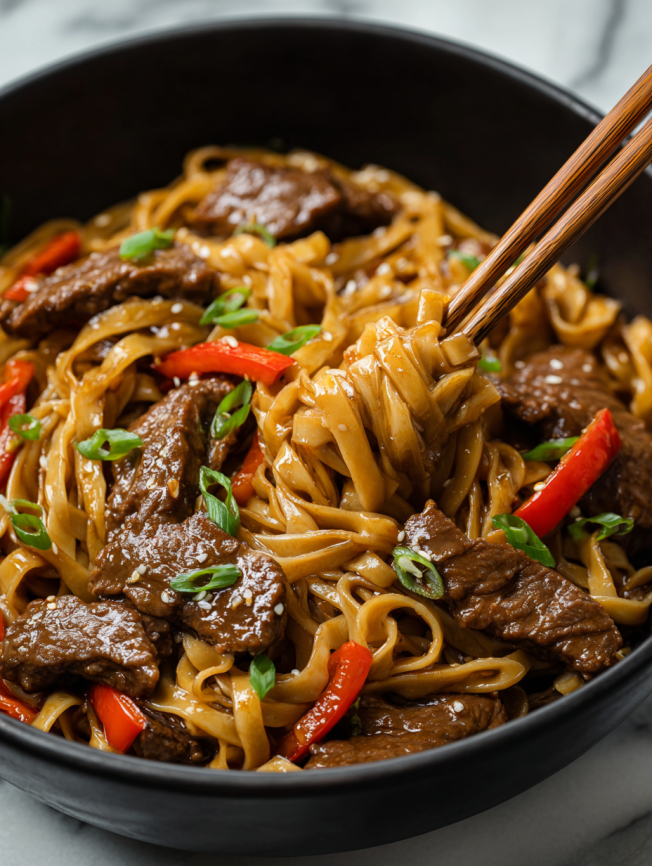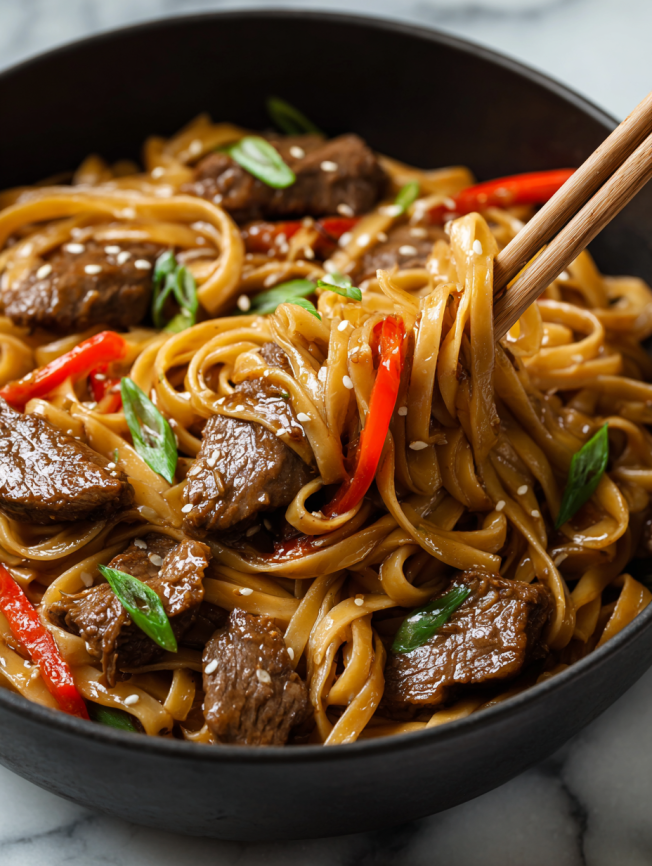Three years ago, during a particularly hectic period when both my husband and I were working late shifts, takeout became our unfortunate dinner default. The breaking point came when my seven-year-old asked if we actually owned a stove anymore. That evening, I challenged myself to create something that could compete with our favorite restaurant’s sticky noodle dish – but in half the time and at a fraction of the cost. The result was these incredible Sticky Beef Noodles that now grace our table weekly.
The genius of this recipe lies in its perfect balance of convenience and sophistication. While the ingredient list might seem extensive, most items are pantry staples that come together effortlessly. Moreover, the glossy, caramelized sauce that coats every strand of noodle creates that coveted restaurant-quality finish that makes ordinary weeknight dinners feel special. Best of all, the entire dish comes together in just 25 minutes, proving that homemade doesn’t have to mean time-consuming.
Why This Recipe Will Transform Your Dinner Routine
Lightning-Fast Execution
Unlike traditional stir-fry recipes that require lengthy prep work, this dish streamlines every step for maximum efficiency. The marinating time overlaps perfectly with sauce preparation and vegetable chopping, eliminating downtime and delivering dinner in record time.
Restaurant-Quality Results
The secret lies in the carefully balanced sauce that creates that signature glossy coating restaurants are famous for. Additionally, proper high-heat cooking techniques ensure tender beef and perfectly crisp vegetables that rival professional kitchens.
Pantry-Friendly Ingredients
Rather than requiring specialty items from Asian markets, this recipe uses accessible ingredients found in most supermarkets. The sauce components are versatile staples that work in countless other dishes, making your grocery investment worthwhile.
Customizable Foundation
Whether you’re accommodating dietary restrictions or simply want variety, this recipe adapts beautifully to different preferences. Swap proteins, adjust vegetables, or modify spice levels while maintaining the core technique that makes this dish exceptional.
Complete Ingredients Collection
Tender Beef Marinade:
- 1 lb beef sirloin or flank steak, thinly sliced against the grain
- 1 tablespoon soy sauce
- 1 tablespoon cornstarch
- 1 teaspoon sesame oil
- 1 teaspoon grated garlic
- ½ teaspoon black pepper
Glossy Sticky Sauce:
- 3 tablespoons soy sauce
- 2 tablespoons hoisin sauce
- 1 tablespoon oyster sauce
- 1 tablespoon brown sugar
- 2 teaspoons rice vinegar or lime juice
- 1 tablespoon water
- 1 teaspoon sriracha (optional)
Fresh Stir-Fry Components:
- 8 oz egg noodles, rice noodles, or ramen
- 1 tablespoon vegetable oil
- 3 cloves garlic, minced
- 1 teaspoon fresh ginger, grated
- 1 small red bell pepper, thinly sliced
- 1 cup snap peas or broccoli florets
- 2 green onions, sliced
- Sesame seeds for garnish (optional)
Detailed Step-by-Step Process
Preparation Phase
Step 1: Marinate for Maximum Tenderness Combine sliced beef with soy sauce, cornstarch, sesame oil, grated garlic, and black pepper in a medium bowl. Mix thoroughly to ensure even coating, then set aside for 10-15 minutes. This crucial step allows the cornstarch to form a protective barrier that keeps the meat tender during high-heat cooking.
Step 2: Create the Signature Sauce While the beef marinates, whisk together all sauce ingredients in a small bowl until the brown sugar dissolves completely. The sauce should have a smooth consistency without any granular texture. Having this ready before cooking begins prevents burning and ensures even distribution.
Noodle Foundation
Step 3: Perfect Noodle Preparation Cook noodles according to package directions until just shy of al dente – they should still have a slight bite. Drain thoroughly and rinse briefly with cold water to stop the cooking process. Toss with a light drizzle of oil to prevent clumping while you prepare the stir-fry components.
High-Heat Cooking Sequence
Step 4: Achieve Perfect Beef Searing Heat vegetable oil in a wok or large skillet over medium-high heat until it shimmers but doesn’t smoke. Add marinated beef in a single layer, working in batches if necessary to avoid overcrowding. Sear for 1-2 minutes per side until golden brown and just cooked through, then transfer to a clean plate.
Step 5: Build Aromatic Vegetable Base Using the same skillet with residual beef flavors, add minced garlic, grated ginger, and sliced bell pepper. Stir-fry for 2-3 minutes until the pepper begins to soften but retains some crispness. The aromatics should be fragrant but not browned.
Step 6: Add Remaining Vegetables Incorporate snap peas or broccoli florets and continue stir-frying for an additional 2 minutes. The vegetables should be bright in color and tender-crisp, maintaining their nutritional value and appealing texture.
Final Assembly Magic
Step 7: Bring It All Together Return the seared beef to the skillet along with the cooked noodles. Pour the prepared sauce over everything and toss vigorously for 2-3 minutes until the sauce reduces slightly and becomes glossy, coating every element beautifully.
Step 8: Fresh Finishing Touches Remove from heat and immediately stir in sliced green onions, which will wilt slightly from the residual heat while maintaining their fresh bite. Serve immediately while the dish is still steaming hot.
Creative Serving Suggestions
Traditional Asian Presentation
Serve in individual bowls with chopsticks and small spoons, garnished with sesame seeds and additional green onions. Provide lime wedges on the side for those who enjoy extra acidity to balance the sweet-savory sauce.
Family-Style Comfort
Present the noodles on a large platter in the center of the table, allowing everyone to serve themselves. This approach works particularly well for casual family dinners and encourages sharing and conversation.
Elevated Dinner Party Option
Plate individual portions in shallow bowls, garnished artfully with julienned vegetables and a sprinkle of toasted sesame seeds. Serve with steamed edamame and jasmine tea for an impressive yet approachable dinner party menu.

Delicious Recipe Variations
Spicy Sichuan Style
Double the sriracha and add 1 teaspoon of chili garlic sauce to the marinade for authentic heat. Garnish with crushed red pepper flakes and serve with cooling cucumber salad to balance the intensity.
Vegetable-Forward Version
Replace half the beef with additional vegetables like mushrooms, carrots, or baby corn. This variation maintains protein content while significantly increasing vegetable intake and creating more colorful presentation.
Seafood Adaptation
Substitute the beef with large shrimp or scallops, reducing the cooking time to 2-3 minutes total to prevent overcooking. The delicate seafood pairs beautifully with the sweet-savory sauce while creating a lighter overall dish.
Gluten-Free Alternative
Use tamari instead of soy sauce and rice noodles instead of wheat-based options. Ensure the hoisin and oyster sauces are certified gluten-free, as formulations can vary between brands.
Make-Ahead Strategies and Storage
Preparation Timeline
Marinate the beef and prepare the sauce up to 24 hours in advance, storing them separately in the refrigerator. Having these components ready transforms this quick recipe into an almost instant dinner option.
Component Storage
Cooked noodles can be prepared earlier in the day and stored covered at room temperature. Toss with a small amount of oil and reheat briefly in the microwave before adding to the stir-fry.
Leftover Management
Store cooked sticky beef noodles in the refrigerator for up to three days, though the texture will soften slightly. Reheat gently in a skillet over medium heat, adding a splash of water or broth to loosen the sauce.
Meal Prep Potential
While best enjoyed fresh, this recipe works well for meal prep when stored properly. Portion into individual containers and reheat in the microwave, stirring halfway through to ensure even heating.
Essential Cooking Techniques
Beef Slicing Mastery: Cut beef against the grain in thin, uniform strips for maximum tenderness. Partially freezing the meat for 15-20 minutes makes slicing much easier and more precise.
Heat Management: Maintain consistent medium-high heat throughout the cooking process to achieve proper searing and prevent steaming. The pan should be hot enough that ingredients sizzle immediately upon contact.
Sauce Timing: Add the sauce only after all other components are cooked to prevent burning the sugars and creating bitter flavors. The residual heat will cook the sauce sufficiently while creating the desired glossy finish.
Noodle Texture: Slightly undercook noodles initially, as they’ll continue cooking when tossed with the hot sauce. This prevents mushy texture and ensures the final dish has proper bite.
Garnish Impact: Fresh garnishes like green onions and sesame seeds aren’t just decorative – they add essential flavor and textural contrast that complete the dish’s overall profile.

Frequently Asked Questions
Q: Can I use different cuts of beef for this recipe? A: Yes! While sirloin and flank steak work best due to their texture, you can also use ribeye, strip steak, or even ground beef. Adjust cooking times accordingly – thicker cuts need slightly longer cooking, while ground beef requires different handling altogether.
Q: What’s the best way to achieve restaurant-style “wok hei” flavor at home? A: Use the highest heat your stove allows, cook in small batches to avoid overcrowding, and keep ingredients moving constantly. A well-seasoned carbon steel or cast iron pan provides better results than non-stick surfaces for achieving that characteristic smoky depth.
Q: Can I make this dish without hoisin or oyster sauce? A: While these sauces provide the signature flavor profile, you can substitute with additional soy sauce plus extra brown sugar for sweetness. However, the unique umami depth that makes this recipe special comes specifically from these traditional Chinese sauces.
Q: How do I prevent the noodles from sticking together during cooking? A: Rinse cooked noodles briefly with cold water to remove excess starch, then toss with a small amount of oil. When reheating or combining with other ingredients, add liquid gradually to loosen any clumps that may have formed.
Q: What vegetables work best in this stir-fry? A: Choose vegetables that cook quickly and maintain crispness, such as bell peppers, snap peas, broccoli, carrots, or mushrooms. Avoid watery vegetables like zucchini or tomatoes, which can make the dish soggy and dilute the sauce.
Q: Can I double this recipe for a larger crowd? A: Yes, but cook in batches to maintain proper heat levels and prevent overcrowding. Use two pans simultaneously if possible, or cook the beef and vegetables in batches before combining everything with the noodles and sauce in a large serving vessel.
Prep Time: 10 minutes
Cook Time: 15 minutes
Total Time: 25 minutes
Servings: 4
Cuisine: Asian-Inspired
These Sticky Beef Noodles prove that exceptional meals don’t require hours of preparation or expensive ingredients. With the right technique and quality components, you can create restaurant-worthy dishes that bring families together and make ordinary weeknights feel extraordinary.

